Western Australia Lean Project 2022
VerifiedAdded on 2022/10/18
|15
|3555
|35
AI Summary
Contribute Materials
Your contribution can guide someone’s learning journey. Share your
documents today.

Running Head: LEAN PROJECT
Lean Project
Name of the Student
Name of the University
Author Note
Lean Project
Name of the Student
Name of the University
Author Note
Secure Best Marks with AI Grader
Need help grading? Try our AI Grader for instant feedback on your assignments.

1LEAN PROJECT
PMBOK process for choosing suburb, land size, builder and stakeholder 800
1a) The chosen suburb is Wellard, Perth in West Australia by the couple for building their dream
house. The reason for choosing this suburb is that it is in second from top for a long time in
Western Australia (Hemsley, 2016). The area of wellard is 16.4 square kilometers and in that area
wetlands and bush-land are surrounded, which results is fresh and health surrounding, fresh air,
greenery for all the people living there. The outdoor lifestyle becomes more peaceful with the
attractive and pleasant surroundings. The features of wellard consists of landscaped parks,
residential estates, pathways for cycling and walking, efficient transport, and facilities for
recreations (Smith & Olaru, 2013). Wellard consists of five Government schools, two private
schools, one government co and one private college .The growing population of wellard is
increasing by the rate of growth of 16.3%. It also consists of rail line that connects Perth with
Mandurah. Both the places can be reached from Wellard within half an hour (Atkins, 2017). Along
with this integrated bus services are available that gives the access of Rockingham and Kwinana.
In order to build the dream house of the couple in the suburb like wellard, the
approximate land size is 550 square meter for two story house with four bedrooms, three
washrooms, one kitchen, one sitting room, a garage for two cars, and a small garden, within the
budget of $269,000. Also, a deposit of AUD$2000 is to be made for signing the land contract
with the land developer that will be refunded later. According to the PMBOK process of project
management the planning for the number of rooms, the estimated budget is made, the financial
forecasting is done on the basis of the couple’s contribution to the budget for their dream house
(Brioso, 2015).
1b) The best builder in wellard is IQ Construction for building the dream house of the couple.
The builders are the locals of wellard and operate from that area only. The builders have
PMBOK process for choosing suburb, land size, builder and stakeholder 800
1a) The chosen suburb is Wellard, Perth in West Australia by the couple for building their dream
house. The reason for choosing this suburb is that it is in second from top for a long time in
Western Australia (Hemsley, 2016). The area of wellard is 16.4 square kilometers and in that area
wetlands and bush-land are surrounded, which results is fresh and health surrounding, fresh air,
greenery for all the people living there. The outdoor lifestyle becomes more peaceful with the
attractive and pleasant surroundings. The features of wellard consists of landscaped parks,
residential estates, pathways for cycling and walking, efficient transport, and facilities for
recreations (Smith & Olaru, 2013). Wellard consists of five Government schools, two private
schools, one government co and one private college .The growing population of wellard is
increasing by the rate of growth of 16.3%. It also consists of rail line that connects Perth with
Mandurah. Both the places can be reached from Wellard within half an hour (Atkins, 2017). Along
with this integrated bus services are available that gives the access of Rockingham and Kwinana.
In order to build the dream house of the couple in the suburb like wellard, the
approximate land size is 550 square meter for two story house with four bedrooms, three
washrooms, one kitchen, one sitting room, a garage for two cars, and a small garden, within the
budget of $269,000. Also, a deposit of AUD$2000 is to be made for signing the land contract
with the land developer that will be refunded later. According to the PMBOK process of project
management the planning for the number of rooms, the estimated budget is made, the financial
forecasting is done on the basis of the couple’s contribution to the budget for their dream house
(Brioso, 2015).
1b) The best builder in wellard is IQ Construction for building the dream house of the couple.
The builders are the locals of wellard and operate from that area only. The builders have

2LEAN PROJECT
experience of more than twenty years in the same field, they have worked in various countries as
well as several industries. They have constructed buildings for both residential and commercial
purpose, therefor they know how to make a house for comfort and efficient to use. They have the
well trained workmanship, focuses mainly on the quality of the services, all the workers of the
company have proper knowledge of their work along with strong expertise. They have the track
record of delivering matching taste of designs with the clients within the given budget. The are
also famous for their flexibility of their work. Also, a contact with Pre-work Construction (PWC)
is to be signed with IQ Construction and deposit of AUD$2000 is to be made which will be
refunded later.
1c)
Internal Stakeholders
Stakeholders Roles Responsibilities
Builders Coordinate work of
the construction of
building.
Manages the project.
The manager directs the
process of building the house
starting from the initial
planning of the house till its
completion (Zhao et al., 2016).
Owners Describes the idea of
the dream house.
Funding of the house.
The owner or the client
checks whether the work is
progressing according to the
plan of the house (Liu et al.,
2014).
The client provides the
experience of more than twenty years in the same field, they have worked in various countries as
well as several industries. They have constructed buildings for both residential and commercial
purpose, therefor they know how to make a house for comfort and efficient to use. They have the
well trained workmanship, focuses mainly on the quality of the services, all the workers of the
company have proper knowledge of their work along with strong expertise. They have the track
record of delivering matching taste of designs with the clients within the given budget. The are
also famous for their flexibility of their work. Also, a contact with Pre-work Construction (PWC)
is to be signed with IQ Construction and deposit of AUD$2000 is to be made which will be
refunded later.
1c)
Internal Stakeholders
Stakeholders Roles Responsibilities
Builders Coordinate work of
the construction of
building.
Manages the project.
The manager directs the
process of building the house
starting from the initial
planning of the house till its
completion (Zhao et al., 2016).
Owners Describes the idea of
the dream house.
Funding of the house.
The owner or the client
checks whether the work is
progressing according to the
plan of the house (Liu et al.,
2014).
The client provides the
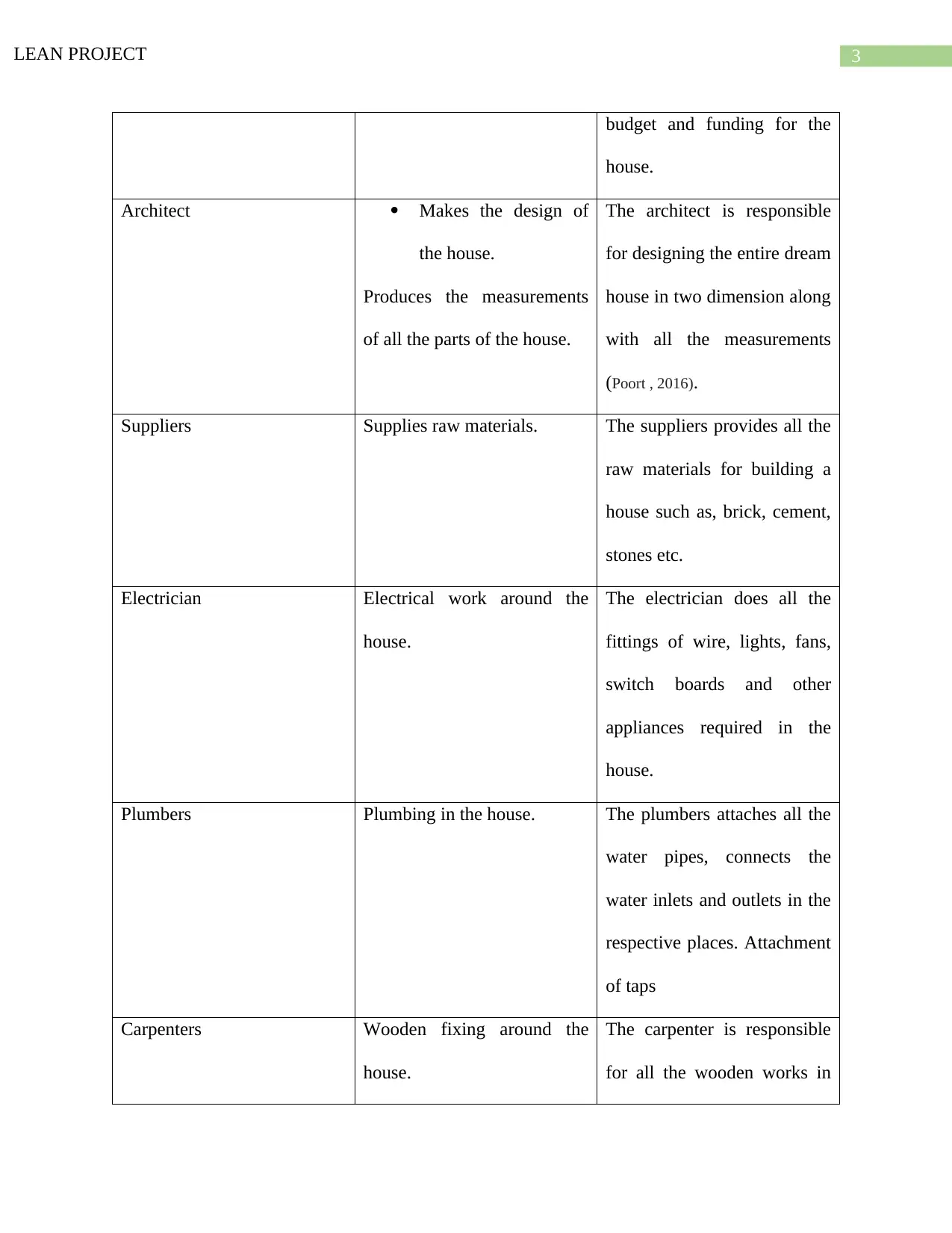
3LEAN PROJECT
budget and funding for the
house.
Architect Makes the design of
the house.
Produces the measurements
of all the parts of the house.
The architect is responsible
for designing the entire dream
house in two dimension along
with all the measurements
(Poort , 2016).
Suppliers Supplies raw materials. The suppliers provides all the
raw materials for building a
house such as, brick, cement,
stones etc.
Electrician Electrical work around the
house.
The electrician does all the
fittings of wire, lights, fans,
switch boards and other
appliances required in the
house.
Plumbers Plumbing in the house. The plumbers attaches all the
water pipes, connects the
water inlets and outlets in the
respective places. Attachment
of taps
Carpenters Wooden fixing around the
house.
The carpenter is responsible
for all the wooden works in
budget and funding for the
house.
Architect Makes the design of
the house.
Produces the measurements
of all the parts of the house.
The architect is responsible
for designing the entire dream
house in two dimension along
with all the measurements
(Poort , 2016).
Suppliers Supplies raw materials. The suppliers provides all the
raw materials for building a
house such as, brick, cement,
stones etc.
Electrician Electrical work around the
house.
The electrician does all the
fittings of wire, lights, fans,
switch boards and other
appliances required in the
house.
Plumbers Plumbing in the house. The plumbers attaches all the
water pipes, connects the
water inlets and outlets in the
respective places. Attachment
of taps
Carpenters Wooden fixing around the
house.
The carpenter is responsible
for all the wooden works in
Secure Best Marks with AI Grader
Need help grading? Try our AI Grader for instant feedback on your assignments.
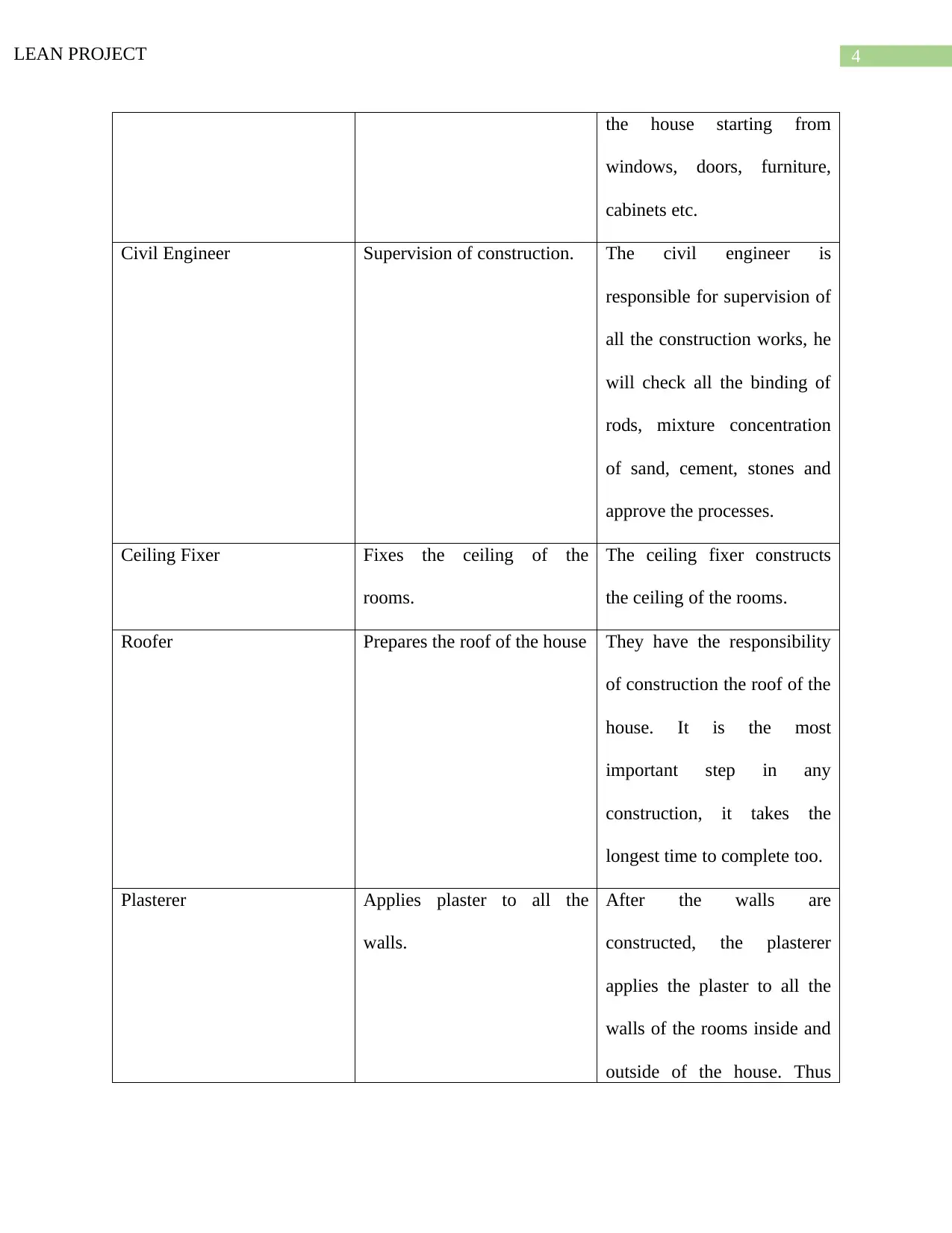
4LEAN PROJECT
the house starting from
windows, doors, furniture,
cabinets etc.
Civil Engineer Supervision of construction. The civil engineer is
responsible for supervision of
all the construction works, he
will check all the binding of
rods, mixture concentration
of sand, cement, stones and
approve the processes.
Ceiling Fixer Fixes the ceiling of the
rooms.
The ceiling fixer constructs
the ceiling of the rooms.
Roofer Prepares the roof of the house They have the responsibility
of construction the roof of the
house. It is the most
important step in any
construction, it takes the
longest time to complete too.
Plasterer Applies plaster to all the
walls.
After the walls are
constructed, the plasterer
applies the plaster to all the
walls of the rooms inside and
outside of the house. Thus
the house starting from
windows, doors, furniture,
cabinets etc.
Civil Engineer Supervision of construction. The civil engineer is
responsible for supervision of
all the construction works, he
will check all the binding of
rods, mixture concentration
of sand, cement, stones and
approve the processes.
Ceiling Fixer Fixes the ceiling of the
rooms.
The ceiling fixer constructs
the ceiling of the rooms.
Roofer Prepares the roof of the house They have the responsibility
of construction the roof of the
house. It is the most
important step in any
construction, it takes the
longest time to complete too.
Plasterer Applies plaster to all the
walls.
After the walls are
constructed, the plasterer
applies the plaster to all the
walls of the rooms inside and
outside of the house. Thus
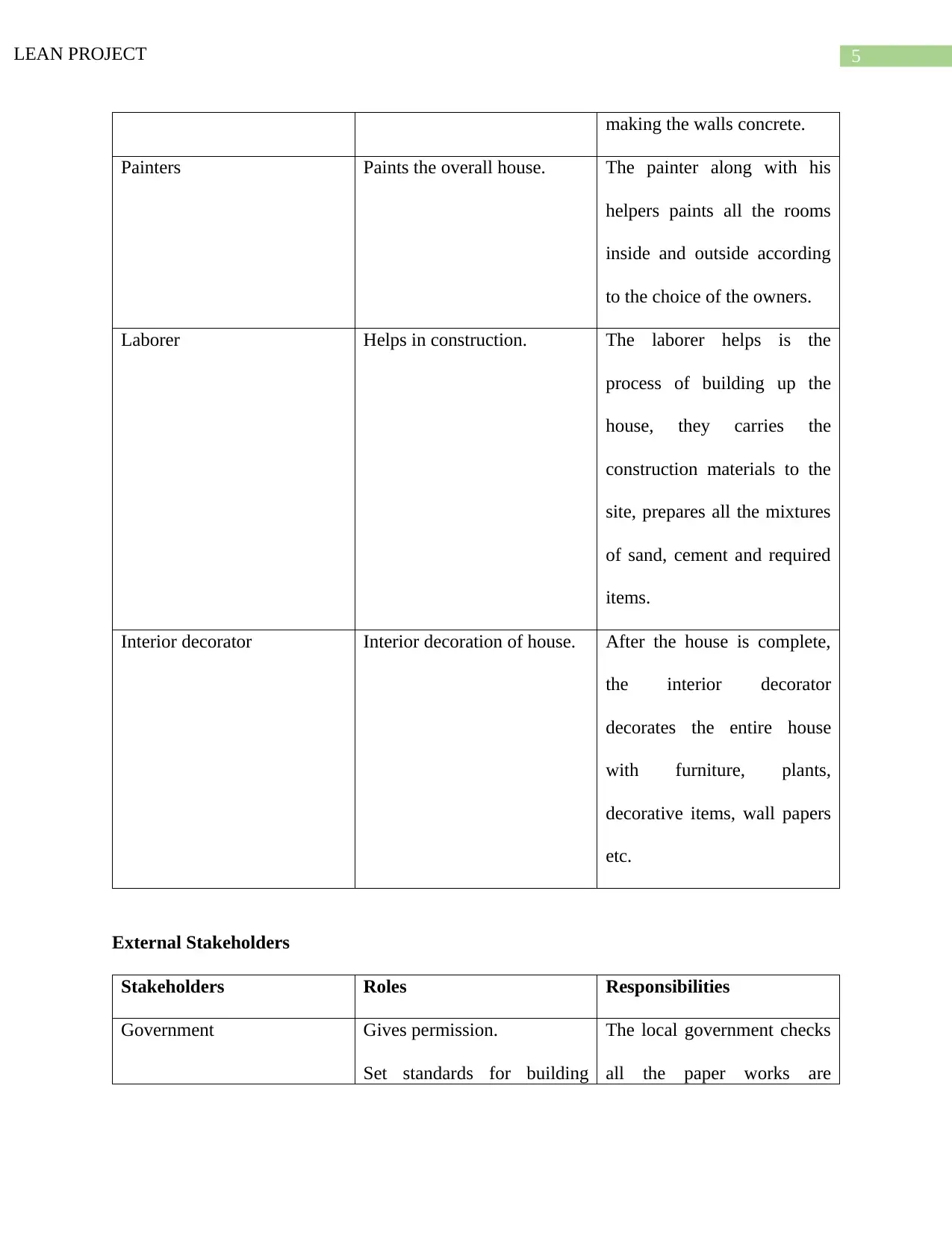
5LEAN PROJECT
making the walls concrete.
Painters Paints the overall house. The painter along with his
helpers paints all the rooms
inside and outside according
to the choice of the owners.
Laborer Helps in construction. The laborer helps is the
process of building up the
house, they carries the
construction materials to the
site, prepares all the mixtures
of sand, cement and required
items.
Interior decorator Interior decoration of house. After the house is complete,
the interior decorator
decorates the entire house
with furniture, plants,
decorative items, wall papers
etc.
External Stakeholders
Stakeholders Roles Responsibilities
Government Gives permission.
Set standards for building
The local government checks
all the paper works are
making the walls concrete.
Painters Paints the overall house. The painter along with his
helpers paints all the rooms
inside and outside according
to the choice of the owners.
Laborer Helps in construction. The laborer helps is the
process of building up the
house, they carries the
construction materials to the
site, prepares all the mixtures
of sand, cement and required
items.
Interior decorator Interior decoration of house. After the house is complete,
the interior decorator
decorates the entire house
with furniture, plants,
decorative items, wall papers
etc.
External Stakeholders
Stakeholders Roles Responsibilities
Government Gives permission.
Set standards for building
The local government checks
all the paper works are
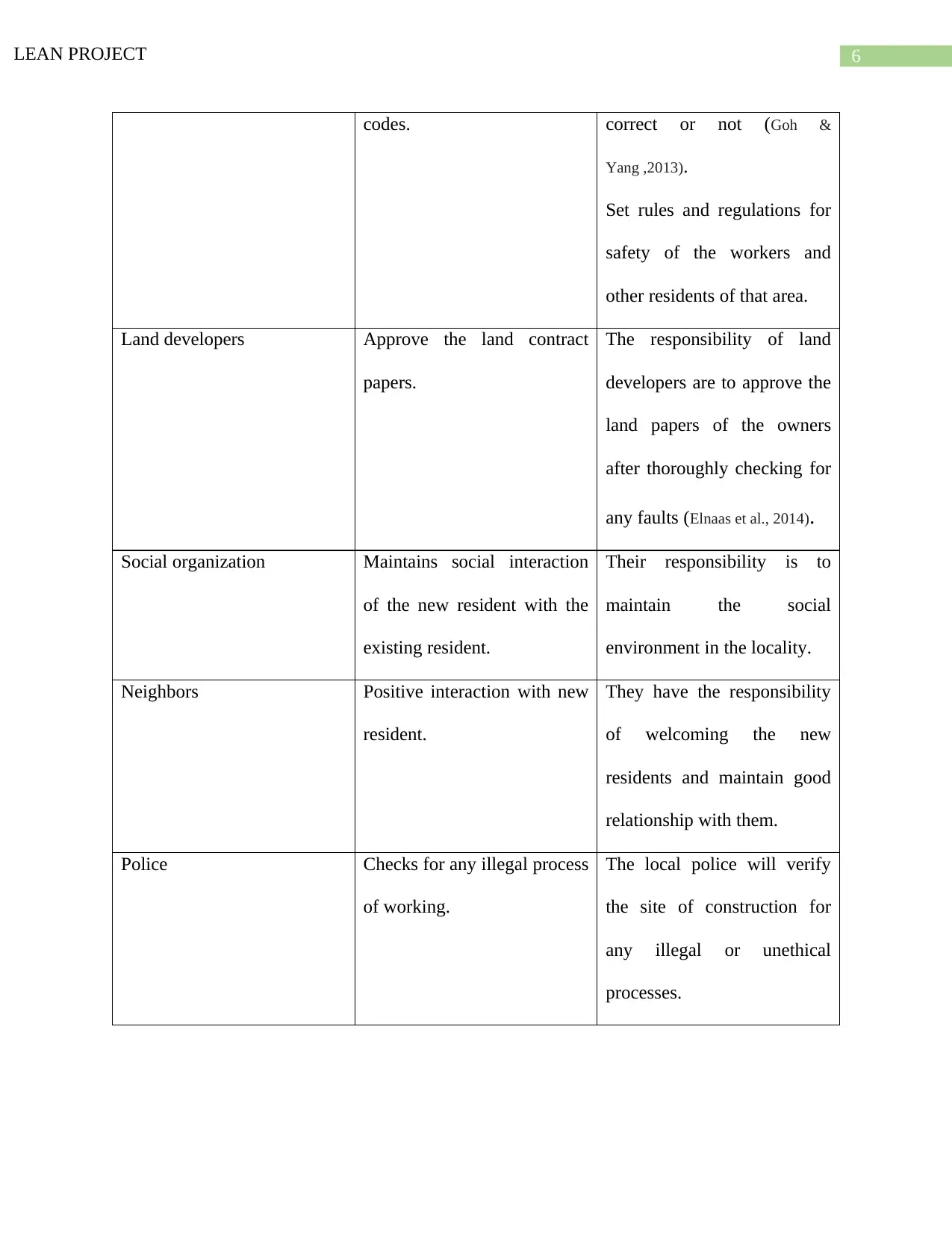
6LEAN PROJECT
codes. correct or not (Goh &
Yang ,2013).
Set rules and regulations for
safety of the workers and
other residents of that area.
Land developers Approve the land contract
papers.
The responsibility of land
developers are to approve the
land papers of the owners
after thoroughly checking for
any faults (Elnaas et al., 2014).
Social organization Maintains social interaction
of the new resident with the
existing resident.
Their responsibility is to
maintain the social
environment in the locality.
Neighbors Positive interaction with new
resident.
They have the responsibility
of welcoming the new
residents and maintain good
relationship with them.
Police Checks for any illegal process
of working.
The local police will verify
the site of construction for
any illegal or unethical
processes.
codes. correct or not (Goh &
Yang ,2013).
Set rules and regulations for
safety of the workers and
other residents of that area.
Land developers Approve the land contract
papers.
The responsibility of land
developers are to approve the
land papers of the owners
after thoroughly checking for
any faults (Elnaas et al., 2014).
Social organization Maintains social interaction
of the new resident with the
existing resident.
Their responsibility is to
maintain the social
environment in the locality.
Neighbors Positive interaction with new
resident.
They have the responsibility
of welcoming the new
residents and maintain good
relationship with them.
Police Checks for any illegal process
of working.
The local police will verify
the site of construction for
any illegal or unethical
processes.
Paraphrase This Document
Need a fresh take? Get an instant paraphrase of this document with our AI Paraphraser
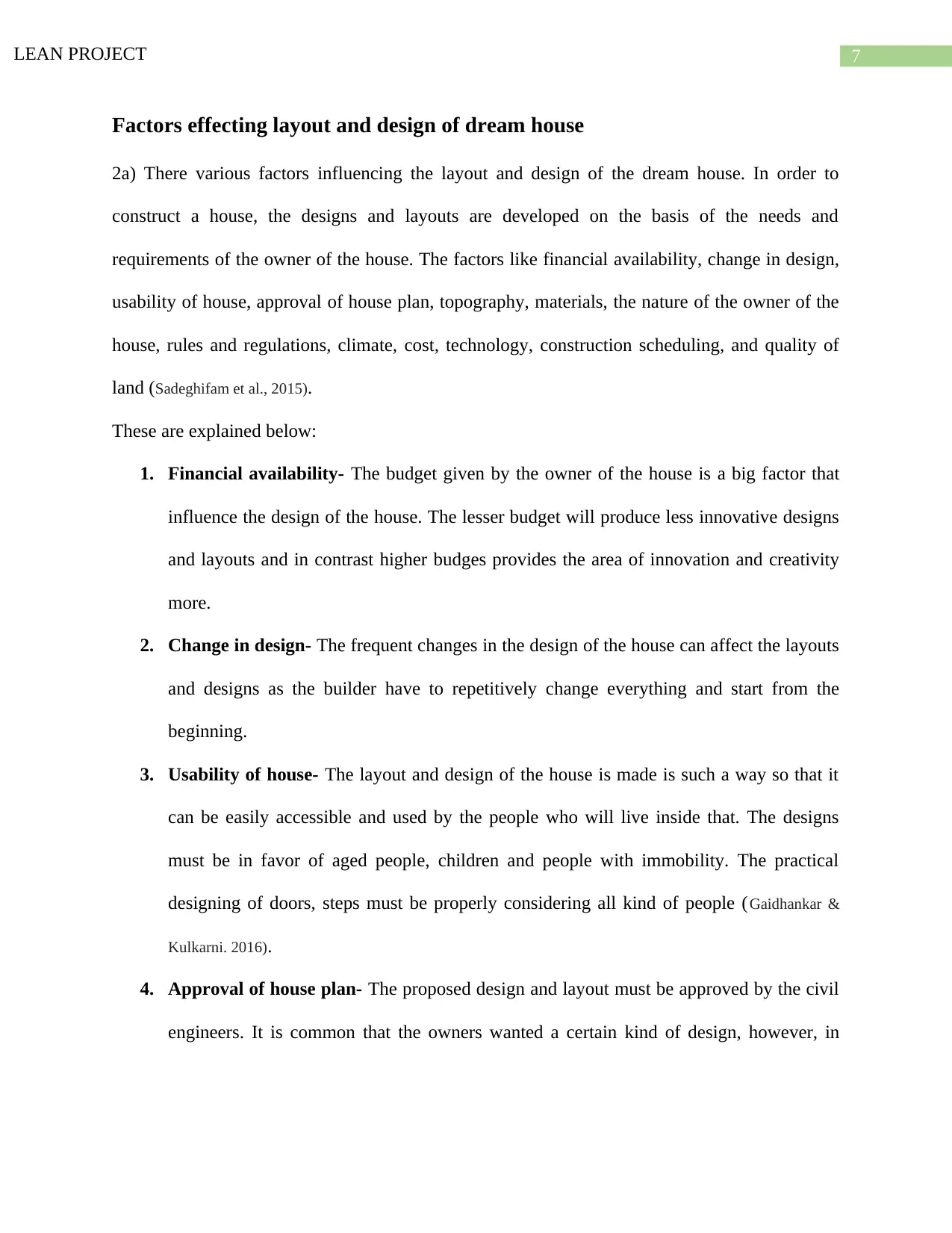
7LEAN PROJECT
Factors effecting layout and design of dream house
2a) There various factors influencing the layout and design of the dream house. In order to
construct a house, the designs and layouts are developed on the basis of the needs and
requirements of the owner of the house. The factors like financial availability, change in design,
usability of house, approval of house plan, topography, materials, the nature of the owner of the
house, rules and regulations, climate, cost, technology, construction scheduling, and quality of
land (Sadeghifam et al., 2015).
These are explained below:
1. Financial availability- The budget given by the owner of the house is a big factor that
influence the design of the house. The lesser budget will produce less innovative designs
and layouts and in contrast higher budges provides the area of innovation and creativity
more.
2. Change in design- The frequent changes in the design of the house can affect the layouts
and designs as the builder have to repetitively change everything and start from the
beginning.
3. Usability of house- The layout and design of the house is made is such a way so that it
can be easily accessible and used by the people who will live inside that. The designs
must be in favor of aged people, children and people with immobility. The practical
designing of doors, steps must be properly considering all kind of people (Gaidhankar &
Kulkarni. 2016).
4. Approval of house plan- The proposed design and layout must be approved by the civil
engineers. It is common that the owners wanted a certain kind of design, however, in
Factors effecting layout and design of dream house
2a) There various factors influencing the layout and design of the dream house. In order to
construct a house, the designs and layouts are developed on the basis of the needs and
requirements of the owner of the house. The factors like financial availability, change in design,
usability of house, approval of house plan, topography, materials, the nature of the owner of the
house, rules and regulations, climate, cost, technology, construction scheduling, and quality of
land (Sadeghifam et al., 2015).
These are explained below:
1. Financial availability- The budget given by the owner of the house is a big factor that
influence the design of the house. The lesser budget will produce less innovative designs
and layouts and in contrast higher budges provides the area of innovation and creativity
more.
2. Change in design- The frequent changes in the design of the house can affect the layouts
and designs as the builder have to repetitively change everything and start from the
beginning.
3. Usability of house- The layout and design of the house is made is such a way so that it
can be easily accessible and used by the people who will live inside that. The designs
must be in favor of aged people, children and people with immobility. The practical
designing of doors, steps must be properly considering all kind of people (Gaidhankar &
Kulkarni. 2016).
4. Approval of house plan- The proposed design and layout must be approved by the civil
engineers. It is common that the owners wanted a certain kind of design, however, in
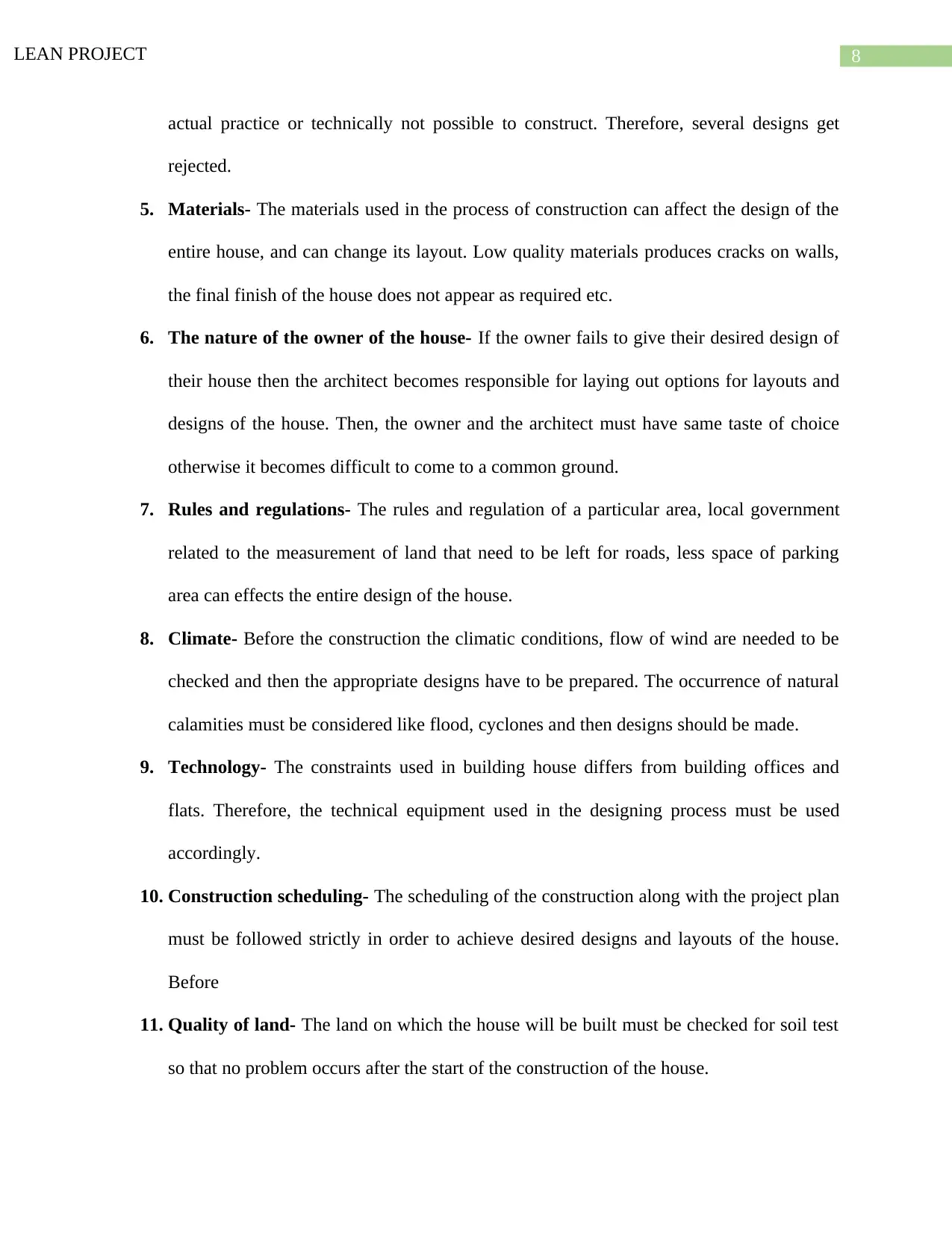
8LEAN PROJECT
actual practice or technically not possible to construct. Therefore, several designs get
rejected.
5. Materials- The materials used in the process of construction can affect the design of the
entire house, and can change its layout. Low quality materials produces cracks on walls,
the final finish of the house does not appear as required etc.
6. The nature of the owner of the house- If the owner fails to give their desired design of
their house then the architect becomes responsible for laying out options for layouts and
designs of the house. Then, the owner and the architect must have same taste of choice
otherwise it becomes difficult to come to a common ground.
7. Rules and regulations- The rules and regulation of a particular area, local government
related to the measurement of land that need to be left for roads, less space of parking
area can effects the entire design of the house.
8. Climate- Before the construction the climatic conditions, flow of wind are needed to be
checked and then the appropriate designs have to be prepared. The occurrence of natural
calamities must be considered like flood, cyclones and then designs should be made.
9. Technology- The constraints used in building house differs from building offices and
flats. Therefore, the technical equipment used in the designing process must be used
accordingly.
10. Construction scheduling- The scheduling of the construction along with the project plan
must be followed strictly in order to achieve desired designs and layouts of the house.
Before
11. Quality of land- The land on which the house will be built must be checked for soil test
so that no problem occurs after the start of the construction of the house.
actual practice or technically not possible to construct. Therefore, several designs get
rejected.
5. Materials- The materials used in the process of construction can affect the design of the
entire house, and can change its layout. Low quality materials produces cracks on walls,
the final finish of the house does not appear as required etc.
6. The nature of the owner of the house- If the owner fails to give their desired design of
their house then the architect becomes responsible for laying out options for layouts and
designs of the house. Then, the owner and the architect must have same taste of choice
otherwise it becomes difficult to come to a common ground.
7. Rules and regulations- The rules and regulation of a particular area, local government
related to the measurement of land that need to be left for roads, less space of parking
area can effects the entire design of the house.
8. Climate- Before the construction the climatic conditions, flow of wind are needed to be
checked and then the appropriate designs have to be prepared. The occurrence of natural
calamities must be considered like flood, cyclones and then designs should be made.
9. Technology- The constraints used in building house differs from building offices and
flats. Therefore, the technical equipment used in the designing process must be used
accordingly.
10. Construction scheduling- The scheduling of the construction along with the project plan
must be followed strictly in order to achieve desired designs and layouts of the house.
Before
11. Quality of land- The land on which the house will be built must be checked for soil test
so that no problem occurs after the start of the construction of the house.

9LEAN PROJECT
2b) From the PMBOK that stands for “Project management body of knowledge” the process are
chosen in order to determine the designs of the dream house (Matos & Lopes, 2013). The process are
categorized in several phases, and those are as follows:
Initiating phase- In this phase, the outline of the dream house is prepared as per the
owner’s choice. The architect prepares the design of the house and all the possible
changes are made. This phase also consist of the budgeting of the house and different
innovative designs are introduced. Also, the different usability of the house is also
verified and designed accordingly. The soil testing is done along with the climatic
condition in wellard.
Planning phase- The planning phase consist of laying out of the plan of the house4. The
proposed house plan is given for approval to the allocated civil engineer. A list is made
for all the raw materials required in the process of building the house (Pearce & Pons, 2013).
The technical equipment required are arranged and finally the schedule of the
construction is made that will be followed throughout the construction.
Execution phase- The execution phase will consist of following the schedule of the plan
in order to construct the dream house in wellard. All the rules and regulations will be
followed that are given by the local government, police and other officials.
Observing phase- This phase involves the participation of managers. The managers and
supervisors observes the overall works of all the workers of the construction. They keeps
the track of the schedule and makes sure that it is strictly followed. If any changes in
design is made that they update the planning schedule accordingly.
Closing phase- In this phase, the construction of the dream house is complete with all the
interior designing, plastering, painting, plumbing, electrical work, furniture setting,
2b) From the PMBOK that stands for “Project management body of knowledge” the process are
chosen in order to determine the designs of the dream house (Matos & Lopes, 2013). The process are
categorized in several phases, and those are as follows:
Initiating phase- In this phase, the outline of the dream house is prepared as per the
owner’s choice. The architect prepares the design of the house and all the possible
changes are made. This phase also consist of the budgeting of the house and different
innovative designs are introduced. Also, the different usability of the house is also
verified and designed accordingly. The soil testing is done along with the climatic
condition in wellard.
Planning phase- The planning phase consist of laying out of the plan of the house4. The
proposed house plan is given for approval to the allocated civil engineer. A list is made
for all the raw materials required in the process of building the house (Pearce & Pons, 2013).
The technical equipment required are arranged and finally the schedule of the
construction is made that will be followed throughout the construction.
Execution phase- The execution phase will consist of following the schedule of the plan
in order to construct the dream house in wellard. All the rules and regulations will be
followed that are given by the local government, police and other officials.
Observing phase- This phase involves the participation of managers. The managers and
supervisors observes the overall works of all the workers of the construction. They keeps
the track of the schedule and makes sure that it is strictly followed. If any changes in
design is made that they update the planning schedule accordingly.
Closing phase- In this phase, the construction of the dream house is complete with all the
interior designing, plastering, painting, plumbing, electrical work, furniture setting,
Secure Best Marks with AI Grader
Need help grading? Try our AI Grader for instant feedback on your assignments.

10LEAN PROJECT
technological installations are made. The owner checks for all his requirements are met or
not and thus closes the project of their dream house.
technological installations are made. The owner checks for all his requirements are met or
not and thus closes the project of their dream house.
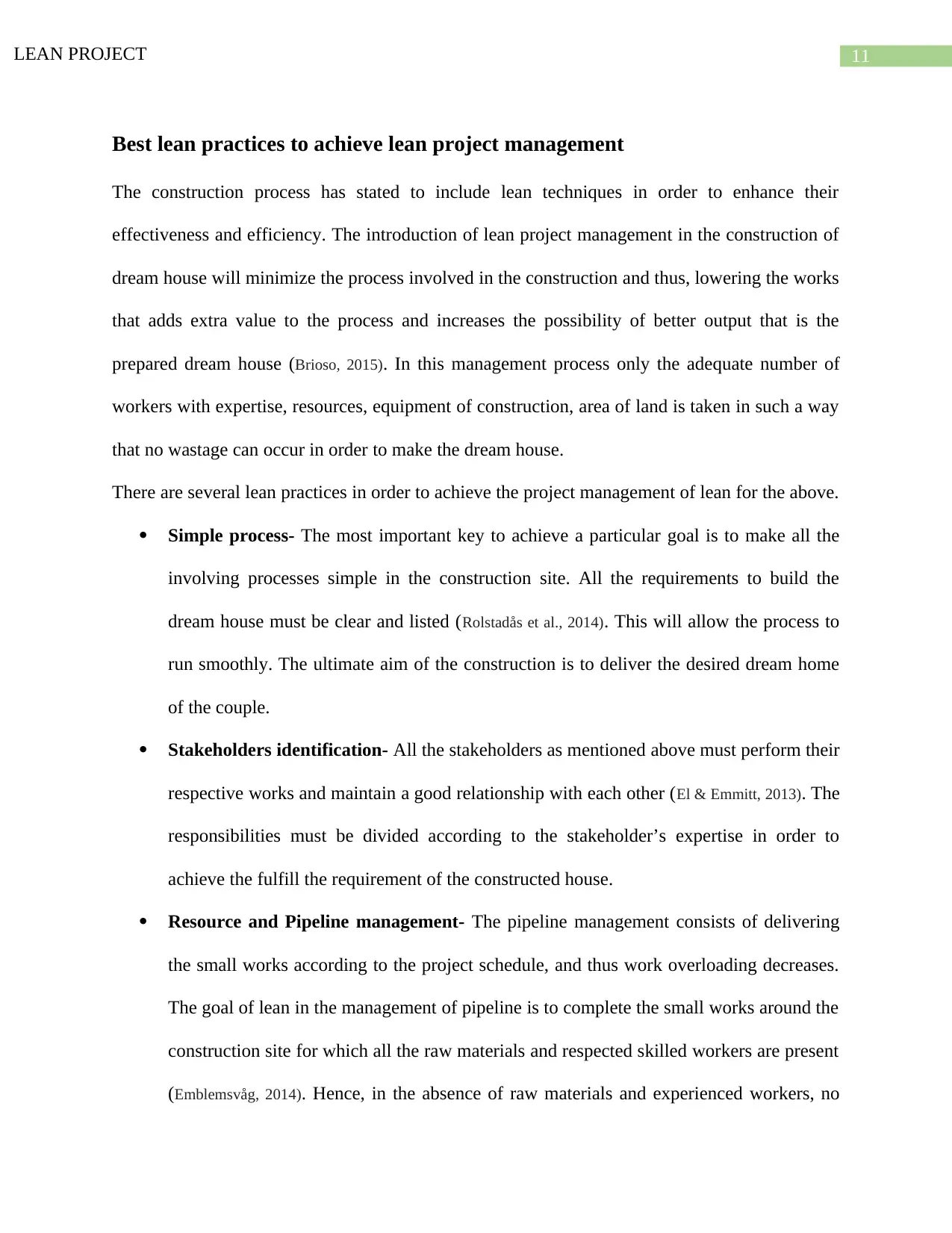
11LEAN PROJECT
Best lean practices to achieve lean project management
The construction process has stated to include lean techniques in order to enhance their
effectiveness and efficiency. The introduction of lean project management in the construction of
dream house will minimize the process involved in the construction and thus, lowering the works
that adds extra value to the process and increases the possibility of better output that is the
prepared dream house (Brioso, 2015). In this management process only the adequate number of
workers with expertise, resources, equipment of construction, area of land is taken in such a way
that no wastage can occur in order to make the dream house.
There are several lean practices in order to achieve the project management of lean for the above.
Simple process- The most important key to achieve a particular goal is to make all the
involving processes simple in the construction site. All the requirements to build the
dream house must be clear and listed (Rolstadås et al., 2014). This will allow the process to
run smoothly. The ultimate aim of the construction is to deliver the desired dream home
of the couple.
Stakeholders identification- All the stakeholders as mentioned above must perform their
respective works and maintain a good relationship with each other (El & Emmitt, 2013). The
responsibilities must be divided according to the stakeholder’s expertise in order to
achieve the fulfill the requirement of the constructed house.
Resource and Pipeline management- The pipeline management consists of delivering
the small works according to the project schedule, and thus work overloading decreases.
The goal of lean in the management of pipeline is to complete the small works around the
construction site for which all the raw materials and respected skilled workers are present
(Emblemsvåg, 2014). Hence, in the absence of raw materials and experienced workers, no
Best lean practices to achieve lean project management
The construction process has stated to include lean techniques in order to enhance their
effectiveness and efficiency. The introduction of lean project management in the construction of
dream house will minimize the process involved in the construction and thus, lowering the works
that adds extra value to the process and increases the possibility of better output that is the
prepared dream house (Brioso, 2015). In this management process only the adequate number of
workers with expertise, resources, equipment of construction, area of land is taken in such a way
that no wastage can occur in order to make the dream house.
There are several lean practices in order to achieve the project management of lean for the above.
Simple process- The most important key to achieve a particular goal is to make all the
involving processes simple in the construction site. All the requirements to build the
dream house must be clear and listed (Rolstadås et al., 2014). This will allow the process to
run smoothly. The ultimate aim of the construction is to deliver the desired dream home
of the couple.
Stakeholders identification- All the stakeholders as mentioned above must perform their
respective works and maintain a good relationship with each other (El & Emmitt, 2013). The
responsibilities must be divided according to the stakeholder’s expertise in order to
achieve the fulfill the requirement of the constructed house.
Resource and Pipeline management- The pipeline management consists of delivering
the small works according to the project schedule, and thus work overloading decreases.
The goal of lean in the management of pipeline is to complete the small works around the
construction site for which all the raw materials and respected skilled workers are present
(Emblemsvåg, 2014). Hence, in the absence of raw materials and experienced workers, no

12LEAN PROJECT
work must be done. The project independencies can be accessed by this and resource
alignment.
Process constraints- For the lean project management, the constraints of the building
process are managed well and enables the continuous flow of the work (Mann, 2017). So
that the work load is evenly distributed among all.
Project as a whole- The blue print and actual project is compared and considered to be a
single project as a whole. It focuses on all the services that this construction will provide
that is five bedrooms, four bedroom and all the other rooms that the blue print consisted
of.
Lean construction tool- This tool is developed, so that the process scheduling in the
construction will be made in such a way that it can relate to the controls needed (Ansah &
Sorooshian, 2017). The ultimate goal is to maintain a health relationship with all.
Efficient performance of workers- The lean practice keeps the record of all the workers
working for building the dream house (Wolniak, 2014). It keeps the track of all the
performances of all the worker. So, that the quality of the house is maintained.
Concurrent design of product and process- All the designs of the rooms are made
previously by the architect (Eaidgah et al., 2016). Along with the construction of the house,
if any updating of design is made by the owners then the construction process is also
modified accordingly.
Clear delivery process- All the checks and verification are made after the completion of
the house. All the electrical appliances, plumbing systems, decorations are checks
thoroughly and then the final house is presented to the couple.
work must be done. The project independencies can be accessed by this and resource
alignment.
Process constraints- For the lean project management, the constraints of the building
process are managed well and enables the continuous flow of the work (Mann, 2017). So
that the work load is evenly distributed among all.
Project as a whole- The blue print and actual project is compared and considered to be a
single project as a whole. It focuses on all the services that this construction will provide
that is five bedrooms, four bedroom and all the other rooms that the blue print consisted
of.
Lean construction tool- This tool is developed, so that the process scheduling in the
construction will be made in such a way that it can relate to the controls needed (Ansah &
Sorooshian, 2017). The ultimate goal is to maintain a health relationship with all.
Efficient performance of workers- The lean practice keeps the record of all the workers
working for building the dream house (Wolniak, 2014). It keeps the track of all the
performances of all the worker. So, that the quality of the house is maintained.
Concurrent design of product and process- All the designs of the rooms are made
previously by the architect (Eaidgah et al., 2016). Along with the construction of the house,
if any updating of design is made by the owners then the construction process is also
modified accordingly.
Clear delivery process- All the checks and verification are made after the completion of
the house. All the electrical appliances, plumbing systems, decorations are checks
thoroughly and then the final house is presented to the couple.
Paraphrase This Document
Need a fresh take? Get an instant paraphrase of this document with our AI Paraphraser
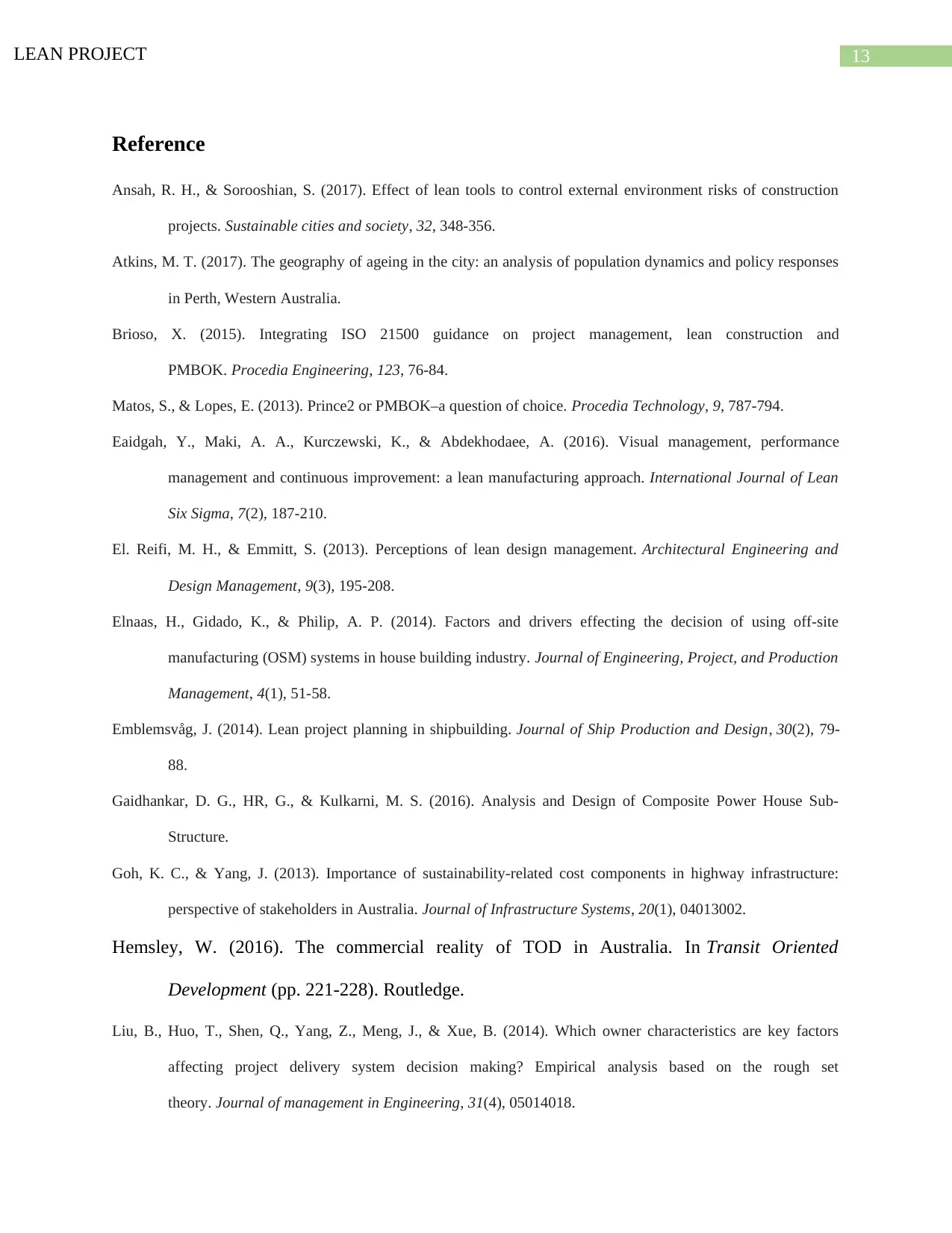
13LEAN PROJECT
Reference
Ansah, R. H., & Sorooshian, S. (2017). Effect of lean tools to control external environment risks of construction
projects. Sustainable cities and society, 32, 348-356.
Atkins, M. T. (2017). The geography of ageing in the city: an analysis of population dynamics and policy responses
in Perth, Western Australia.
Brioso, X. (2015). Integrating ISO 21500 guidance on project management, lean construction and
PMBOK. Procedia Engineering, 123, 76-84.
Matos, S., & Lopes, E. (2013). Prince2 or PMBOK–a question of choice. Procedia Technology, 9, 787-794.
Eaidgah, Y., Maki, A. A., Kurczewski, K., & Abdekhodaee, A. (2016). Visual management, performance
management and continuous improvement: a lean manufacturing approach. International Journal of Lean
Six Sigma, 7(2), 187-210.
El. Reifi, M. H., & Emmitt, S. (2013). Perceptions of lean design management. Architectural Engineering and
Design Management, 9(3), 195-208.
Elnaas, H., Gidado, K., & Philip, A. P. (2014). Factors and drivers effecting the decision of using off-site
manufacturing (OSM) systems in house building industry. Journal of Engineering, Project, and Production
Management, 4(1), 51-58.
Emblemsvåg, J. (2014). Lean project planning in shipbuilding. Journal of Ship Production and Design, 30(2), 79-
88.
Gaidhankar, D. G., HR, G., & Kulkarni, M. S. (2016). Analysis and Design of Composite Power House Sub-
Structure.
Goh, K. C., & Yang, J. (2013). Importance of sustainability-related cost components in highway infrastructure:
perspective of stakeholders in Australia. Journal of Infrastructure Systems, 20(1), 04013002.
Hemsley, W. (2016). The commercial reality of TOD in Australia. In Transit Oriented
Development (pp. 221-228). Routledge.
Liu, B., Huo, T., Shen, Q., Yang, Z., Meng, J., & Xue, B. (2014). Which owner characteristics are key factors
affecting project delivery system decision making? Empirical analysis based on the rough set
theory. Journal of management in Engineering, 31(4), 05014018.
Reference
Ansah, R. H., & Sorooshian, S. (2017). Effect of lean tools to control external environment risks of construction
projects. Sustainable cities and society, 32, 348-356.
Atkins, M. T. (2017). The geography of ageing in the city: an analysis of population dynamics and policy responses
in Perth, Western Australia.
Brioso, X. (2015). Integrating ISO 21500 guidance on project management, lean construction and
PMBOK. Procedia Engineering, 123, 76-84.
Matos, S., & Lopes, E. (2013). Prince2 or PMBOK–a question of choice. Procedia Technology, 9, 787-794.
Eaidgah, Y., Maki, A. A., Kurczewski, K., & Abdekhodaee, A. (2016). Visual management, performance
management and continuous improvement: a lean manufacturing approach. International Journal of Lean
Six Sigma, 7(2), 187-210.
El. Reifi, M. H., & Emmitt, S. (2013). Perceptions of lean design management. Architectural Engineering and
Design Management, 9(3), 195-208.
Elnaas, H., Gidado, K., & Philip, A. P. (2014). Factors and drivers effecting the decision of using off-site
manufacturing (OSM) systems in house building industry. Journal of Engineering, Project, and Production
Management, 4(1), 51-58.
Emblemsvåg, J. (2014). Lean project planning in shipbuilding. Journal of Ship Production and Design, 30(2), 79-
88.
Gaidhankar, D. G., HR, G., & Kulkarni, M. S. (2016). Analysis and Design of Composite Power House Sub-
Structure.
Goh, K. C., & Yang, J. (2013). Importance of sustainability-related cost components in highway infrastructure:
perspective of stakeholders in Australia. Journal of Infrastructure Systems, 20(1), 04013002.
Hemsley, W. (2016). The commercial reality of TOD in Australia. In Transit Oriented
Development (pp. 221-228). Routledge.
Liu, B., Huo, T., Shen, Q., Yang, Z., Meng, J., & Xue, B. (2014). Which owner characteristics are key factors
affecting project delivery system decision making? Empirical analysis based on the rough set
theory. Journal of management in Engineering, 31(4), 05014018.
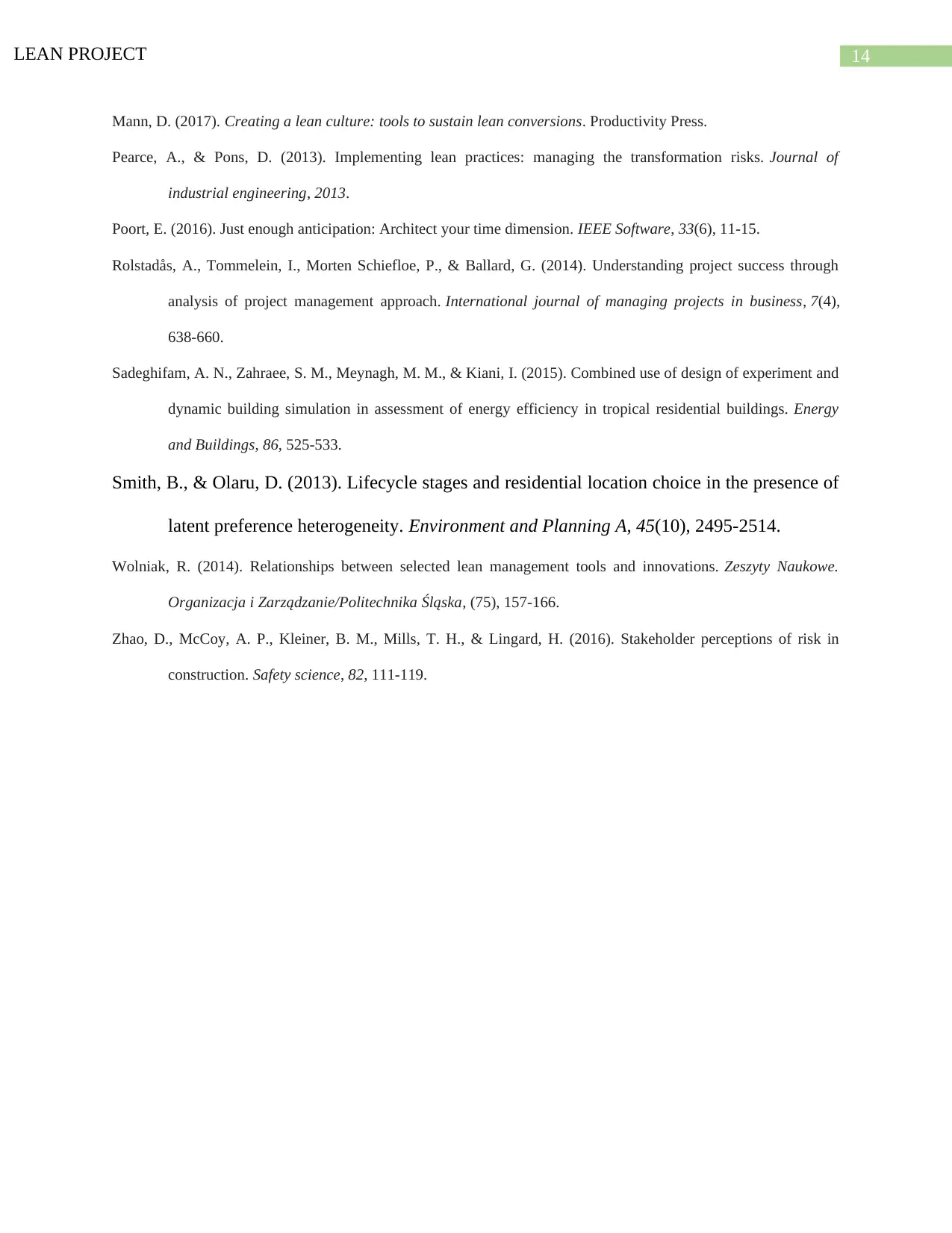
14LEAN PROJECT
Mann, D. (2017). Creating a lean culture: tools to sustain lean conversions. Productivity Press.
Pearce, A., & Pons, D. (2013). Implementing lean practices: managing the transformation risks. Journal of
industrial engineering, 2013.
Poort, E. (2016). Just enough anticipation: Architect your time dimension. IEEE Software, 33(6), 11-15.
Rolstadås, A., Tommelein, I., Morten Schiefloe, P., & Ballard, G. (2014). Understanding project success through
analysis of project management approach. International journal of managing projects in business, 7(4),
638-660.
Sadeghifam, A. N., Zahraee, S. M., Meynagh, M. M., & Kiani, I. (2015). Combined use of design of experiment and
dynamic building simulation in assessment of energy efficiency in tropical residential buildings. Energy
and Buildings, 86, 525-533.
Smith, B., & Olaru, D. (2013). Lifecycle stages and residential location choice in the presence of
latent preference heterogeneity. Environment and Planning A, 45(10), 2495-2514.
Wolniak, R. (2014). Relationships between selected lean management tools and innovations. Zeszyty Naukowe.
Organizacja i Zarządzanie/Politechnika Śląska, (75), 157-166.
Zhao, D., McCoy, A. P., Kleiner, B. M., Mills, T. H., & Lingard, H. (2016). Stakeholder perceptions of risk in
construction. Safety science, 82, 111-119.
Mann, D. (2017). Creating a lean culture: tools to sustain lean conversions. Productivity Press.
Pearce, A., & Pons, D. (2013). Implementing lean practices: managing the transformation risks. Journal of
industrial engineering, 2013.
Poort, E. (2016). Just enough anticipation: Architect your time dimension. IEEE Software, 33(6), 11-15.
Rolstadås, A., Tommelein, I., Morten Schiefloe, P., & Ballard, G. (2014). Understanding project success through
analysis of project management approach. International journal of managing projects in business, 7(4),
638-660.
Sadeghifam, A. N., Zahraee, S. M., Meynagh, M. M., & Kiani, I. (2015). Combined use of design of experiment and
dynamic building simulation in assessment of energy efficiency in tropical residential buildings. Energy
and Buildings, 86, 525-533.
Smith, B., & Olaru, D. (2013). Lifecycle stages and residential location choice in the presence of
latent preference heterogeneity. Environment and Planning A, 45(10), 2495-2514.
Wolniak, R. (2014). Relationships between selected lean management tools and innovations. Zeszyty Naukowe.
Organizacja i Zarządzanie/Politechnika Śląska, (75), 157-166.
Zhao, D., McCoy, A. P., Kleiner, B. M., Mills, T. H., & Lingard, H. (2016). Stakeholder perceptions of risk in
construction. Safety science, 82, 111-119.
1 out of 15
Related Documents
Your All-in-One AI-Powered Toolkit for Academic Success.
+13062052269
info@desklib.com
Available 24*7 on WhatsApp / Email
![[object Object]](/_next/static/media/star-bottom.7253800d.svg)
Unlock your academic potential
© 2024 | Zucol Services PVT LTD | All rights reserved.





